how to find correlation coefficient in excel
3 Ways to Summate a Pearson's Correlation Coefficient in Excel
If you've ever learnt some statistics, so y'all've probably come across the correlation coefficient.
Just tin can you calculate this in Excel?
Yes, y'all can!
Excel can be a smashing tool for a statistician when you know how to use it.
In this postal service, I'll show you lot iii means to summate the correlation coefficient in Excel.
Video Tutorial
What is a Correlation Coeffecient?
The correlation coefficient is too known equally the Pearson Correlation Coefficient and it is a measurement of how related two variables are.
The calculation tin have a value betwixt 0 and 1.
A value of 0 indicates the two variables are highly unrelated and a value of one indicates they are highly related.
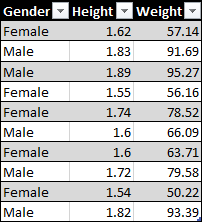
For instance, y'all might have data on meridian (meters) and weight (kilograms) for a sample of people and want to know if these two variables are related.
Intuitively, you lot would think a person's height and weight are related, only the correlation coefficient will show you mathematically how related or unrelated these are.
Correlation Coefficient Formula

The correlation coefficient r can exist calculated with the higher up formula where ten and y are the variables which you want to exam for correlation.
In this case, the 10 variable is the height and the y variable is the weight. r is and then the correlation between acme and weight.
Calculating the Correlation Coefficient from the Definition
Let's meet how we tin can summate this in Excel based on the in a higher place definition.
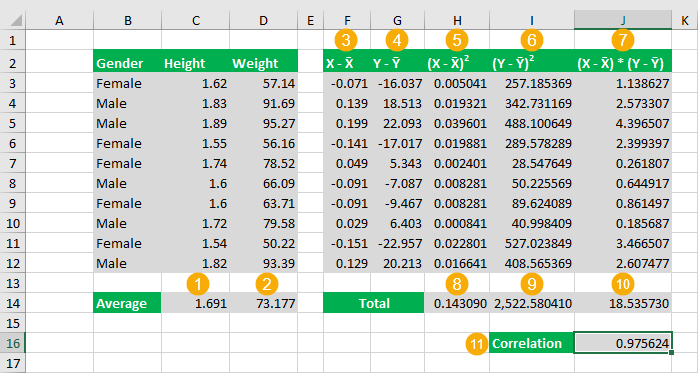
There are quite a few steps involved to summate the correlation coefficient from scratch.
- Calculate the average height.
= Average ( C3:C12 ) - Calculate the average weight.
= Average ( D3:D12 ) - Calculate the deviation betwixt the elevation and average peak for each data point. This formula will need to exist copied down for each row.
= C3 - $C$14 - Calculate the difference between the weight and average weight for each data point. This formula will need to be copied downward for each row.
= D3 - $D$fourteen - Calculate the square of the difference from pace 3 for each row.
= Power ( F3, two ) - Calculate the foursquare of the divergence from step 4 for each row.
= Ability ( G3, 2 ) - Calculate the production of differences from footstep iii and 4 for each row.
= F3 * G3 - Calculate the sum of the squared differences from step five.
= SUM ( H3:H12 ) - Calculate the sum of the squared differences from footstep 6.
= SUM ( I3:I12 ) - Calculate the sum of the product of differences from pace 7.
= SUM ( J3:J12 ) - Summate the correlation with the following formula.
= J14 / ( SQRT ( H14 ) * SQRT ( I14 ) )
It's quite an involved calculation with a lot of intermediate steps.
Thankfully Excel has a built in function for getting the correlation which makes the adding much more simple.
CORREL Role
This is a function specifically for calculating the Pearson correlation coefficient in Excel.
It'due south very like shooting fish in a barrel to use. Information technology takes two ranges of values as the but two arguments.
= CORREL ( Variable1, Variable2 ) - Variable1 and Variable2 are the two variables which yous want to calculate the Pearson Correlation Coefficient betwixt.
- These are required inputs and must exist a single column or single row array of numbers. Variable1 and Variable2 must also have the aforementioned dimension.
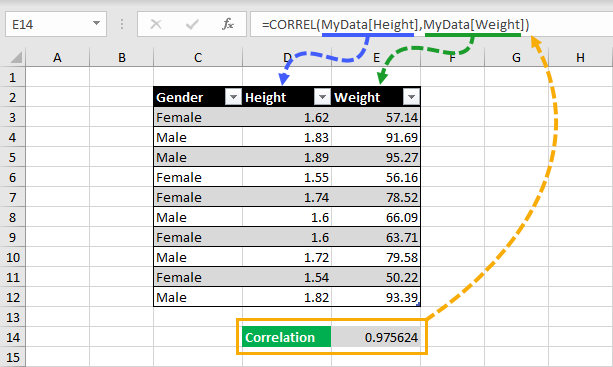
= CORREL ( Height, Weight ) The above formula is what you would need to summate the correlation between height and weight.
Wow, so much easier than calculating it from scratch!
This method is also dynamic. If your data changes, the correlation calculation will update to reflect the new data.
Statistical Tools
Excel comes with a powerful statistical tools add-in, but you need to enable it to use it first and it'south quite subconscious.

To enable the Analysis ToolPak:
- Go to the File tab and then choose Options.
- Become to the Add-ins tab in the Excel Options.
- Choose Excel Add together-ins from the driblet-down listing and press the Become button.
- Check the Assay ToolPak option from the bachelor add-ins.
- Printing the OK button.

Y'all will at present accept a Data Assay command available in the Data tab and you tin click on this to open up up the Assay ToolPak.
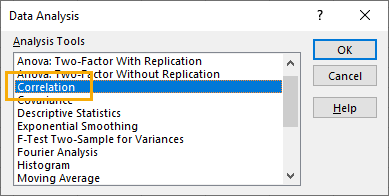
This will open the Data Analysis menu and y'all can then select Correlation from the options and press the OK push button.
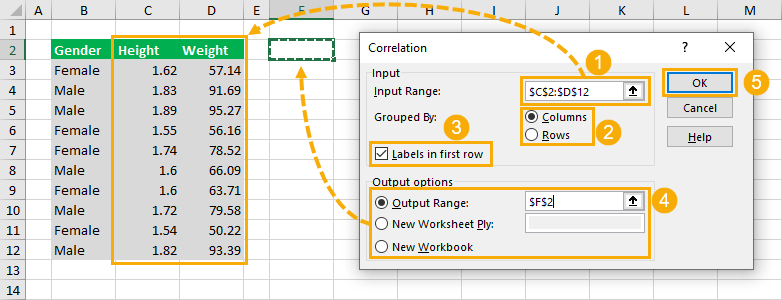
This volition open upwardly the Data Analysis Correlation menu.
- Supply the Input Range for the correlation calculation. This should be a range with numerical values organized into columns or rows.
- Select the Group Past pick of Columns or Rows. This example has the information organized by columns equally values for tiptop are all in one column and values for weight are in a divide column.
- Select whether or non your input range has Labels in the first row. These labels are used afterward in the output so it'southward best to select an input range that includes the labels.
- Select where to place the output in the Output options. You can choose from a location in the current sheet, a location in a new canvas, or a new workbook.
- Printing the OK button create the calculation.
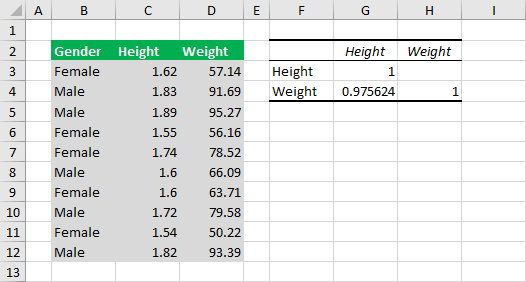
This will output a correlation matrix.
This means if you lot take more than than two columns of variable, the matrix will contain the correlation coefficient for all combinations of variables.
The drawback of this method is the output is static. If your data changes, you volition need to rerun the data analysis to update the correlation matrix.
Conclusions
Correlation is a very useful statistic to decide if your information is related.
The mathematical formula can be intimidating though, especially when trying to calculate it in Excel.
Thankfully there are a few like shooting fish in a barrel means to implement this calculation in Excel.
Nearly the Author
![]()
John is a Microsoft MVP and freelance consultant and trainer specializing in Excel, Power BI, Power Automate, Ability Apps and SharePoint. You can find other interesting manufactures from John on his blog or YouTube channel.
Source: https://www.howtoexcel.org/correlation-coefficient/
Posted by: bailesbuteatelf38.blogspot.com

0 Response to "how to find correlation coefficient in excel"
Post a Comment